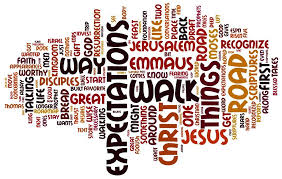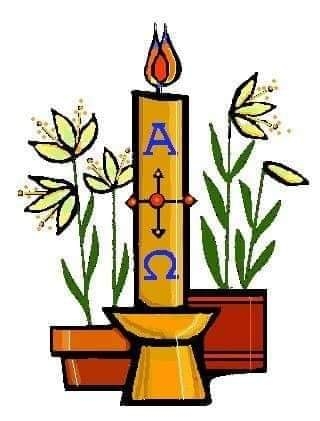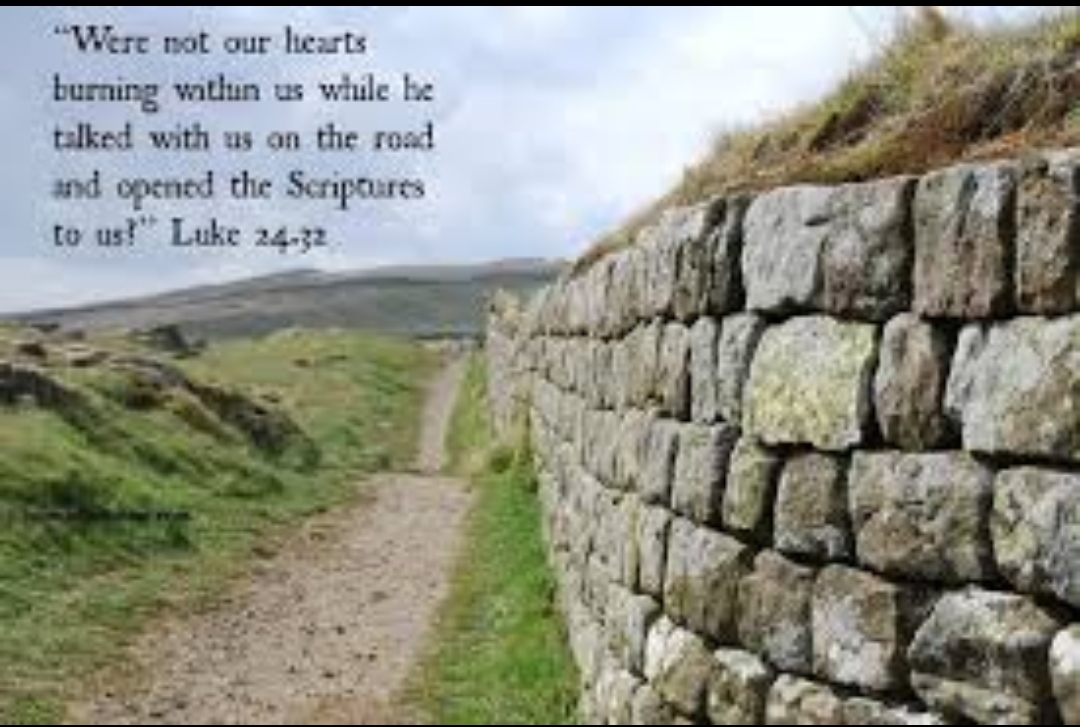 St Alban’s Episcopal Church Bolivar, Missouri Easter Wednesday, April 20, 2022 Another Easter story Luke 24:13-35 The journey to Emmaus  Luke 24:13-35 On the first day of the week, two of Jesus’ disciples were going to a village called Emmaus, about seven miles from Jerusalem, and talking with each other about all the things that had happened. While they were talking and discussing, Jesus himself came near and went with them, but their eyes were kept from recognizing him. And he said to them, “What are you discussing with each other as you walk along?” They stood still, looking sad. The one of them, whose name was Cleopas, answered him, “Are you the only stranger in Jerusalem who does not know the things that have taken place there in these days?” He asked them, “What things?” They replied, “The thing about Jesus of Nazareth, who was a prophet mighty in deed and word before God and all the people, and how our chief priests and leaders handed him over to be condemned to death and crucified him. But we had hoped that he was the one to redeem Israel. Yes, and besides all this, it is now the third day since these things took place. Moreover some women of our group astounded us. They were at the tomb early this morning, and when they did not find his body there, they came back and told us they they had indeed seen a vision of angels, who said that he was alive. Some of those who were with us went to the tomb and found it just as the women had said, but they did not see him.”That the Messiah should suffer all these things and then enter into his glory?” Then beginning with Moses and all the prophets, he interpreted to them the things about himself in all the scripture. As they came near to the village where they were going, he walked ahead as if he were going on. But they urged him strongly, saying, “Stay with us, because it is almost evening and the day is now nearly over.” So he went in to stay with them. He was at the table with them, he took bread, blessed and broke it, and gave it to them. Then their eyes were opened, and they recognized him; and he vanished from their sight. They said to each other, “Were not our heats burning within us while he was talking to us on the road, while he was opening the scriptures to us?” That same hour they got up and returned to Jerusalem; they found the eleven and their companions gathered together. They were saying, “The Lord has risen indeed, and he has appeared to Simon!” Then they told what had happened on the road, and how he had been made known to them in the breaking of the bread.   So – who was that other disciple? If you are like most people, you probably simply assume it was another man. And maybe it was. But why do you assume that? Do you really think that all of Jesus’ disciples were men? We know they weren’t. But still, we tend to forget. Even within this account, Cleopas specifically mentions that the women who went to the tomb were, “of our group.” What if the other person, unnamed, was Cleopas’ wife? It makes sense in the story. Clearly, the two were going home to Emmaus. It was their destination. And when they reached it, “they strongly urged him,” to “stay with us.” That’s typical desert hospitality. It was evening; they wouldn’t have wanted him to be out on the road hungry, alone at night. The place seems to have been their home. It wouldn’t have been unusual for Jesus to have discussed the scriptures with a woman; he had a habit of doing that. But they had no idea who he was. That, too, is typical of Jesus’ post-resurrection appearances. Nobody recognized him at first. That’s worth a whole discussion all by itself. For now, notice how they did come to know him. It was not by his words and teaching, even though “our hearts were burning within us” while he talked and explained scripture. It was “in the breaking of the bread.” By the time Luke wrote this gospel, that phrase had become part of the weekly eucharistic celebration which included, always, the elements we see here: He took the bread, he blessed the bread, he broke it and he gave it to his friends. It is what he had done at his last supper – and the actions are the words, even if they are not spoken: “this is my body…given for you.” This isn’t the only way we know him, but it is a real way. It isn’t as we talk about Jesus offering himself for us, but as we enact it – as we do what he told us to do, as we physically take real bread and real wine and act out the story week by week that we “remember.” it. As his presence is known. It is embodied truth. The little ones don’t yet begin to understand it with their intellects, but they do know that love is present in it, that this story matters, that it is theirs, that we are, that God is. And that is why they run up as soon as they see me beginning the Eucharistic prayer. They are dancing with God already. And it is what we want them to do. They can reflect on it forever after, as we all do. They will grow up in knowledge and understanding. But right now, the actions are the first way into their hearts. And they will not forget. Jesus simply vanished; the resurrection body of Jesus walks through closed doors, and comes and goes as he pleases. It’s a real body, a real physical body, but it isn’t the same as it was before his death and resurrection. But neither of the disciples thought he was was a ghost – or an angel. And they went straight back to tell the others. This is my favorite of the Easter stories, because it is the most accessible to us. No matter how tired I am, how anxious or distracted or concerned about the world’s sorrows I might be on Saturday night or Sunday before Church, no matter how much I doubt the whole things some days, it never fails – I always recognize him “in the breaking of the bread.” Others have, too, throughout all these many hundreds of years. And that is why we do it week after week.   |

Categories:
Tags:
No responses yet